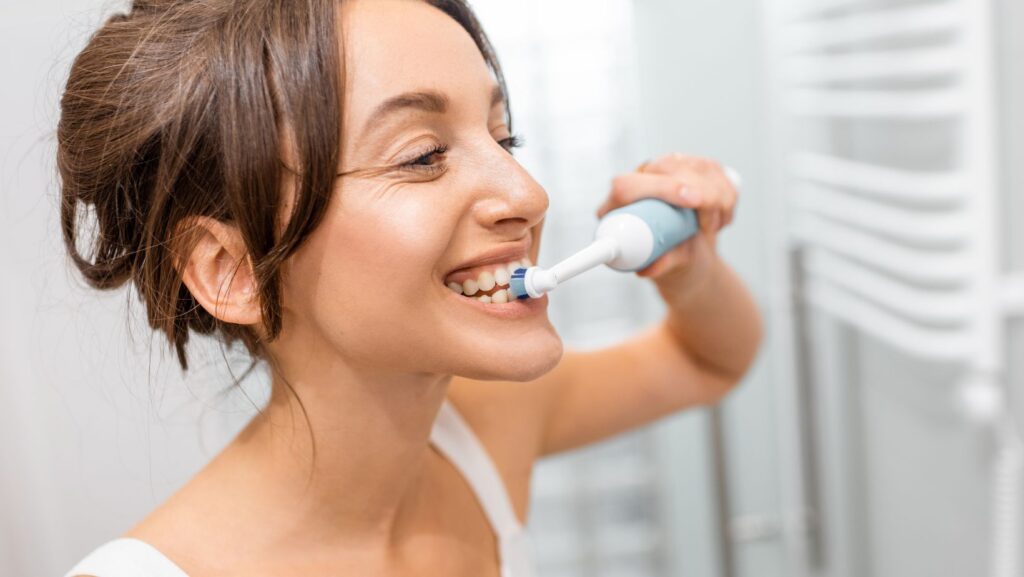
Though electric toothbrushes experienced a significant boom in the 2000s, their effectiveness is still questionable by some rational patients. If you doubt whether the pros of using a powered toothbrush outweigh its cons, we can dot the i’s by providing a comprehensive overview of its effectiveness. How does this miraculous brush work? How to choose one that will faithfully serve you for a long time? Read on to learn the answers!
How Electric Toothbrushes Work
The first General Electric Automatic Toothbrush appeared on the market in the early 1960s, working from rechargeable batteries. This dental device has only modernized since then, but it is still equipped with a rechargeable battery. Its working principle is straightforward: the brush uses electricity to rapidly move a small head at high speed. It efficiently dislodges plaque and food particles from your teeth and gums.
There are two types of powered toothbrush technology:
- Oscillating-rotating technology implies the brush head spinning and rotation for thorough cleaning;
- Sonic technology leverages ultrasound and sonic waves to vibrate while brushing. Some models are even equipped with Bluetooth to send data about your brushing habits to a smartphone app!
Recent models have inbuilt two-minute timers to ensure an appropriate longevity of the brushing session.
Benefits of Using an Electric Toothbrush
Electric toothbrushes can greatly simplify your home care by smoothly cleaning plaque, tartar, and staining. You don’t need to conduct a multitude of movements as with manual brushes.

Let’s discover the key benefits of a powered toothbrush:
- Meticulous plaque removal. Electric toothbrushes effectively break down plaque by producing thousands of strokes per minute.
- Ease of use. Powered toothbrushes spare you from the hassle of wiggling your hand, which can be indispensable for people with limited hand mobility.
- Kid-friendly. Children are more prone to brushing their teeth with an eye-catching, vividly colored electric toothbrush, perceiving it as an interactive toy. This contributes to proper brushing habits development.
- Suitable for sensitive gums. Excessive pressure while brushing manually can cause gum recession. Electric toothbrushes are frequently equipped with pressure sensors that mark if you’re pressing too hard.
- Extra features. Some electric toothbrushes offer multiple brushing modes and other advantageous built-in features to help you stick to proper brushing techniques and customize your oral routine.
Potential Downsides of Electric Toothbrushes
Electric toothbrushes have a few potential downsides to take into account before purchase:
- The risk of brushing too hard. However, it remains when using a manual toothbrush. Be gentle and mindful while brushing so as not to harm tooth enamel and gums or choose a model with pressure sensors to ensure you’re playing it safe.
- Cost. Compared to manual toothbrushes, electric ones are more expensive. Besides, you need to invest in new brush heads after around three months of consistent use.
- Potential discomfort. Some people like the sensation of brush rotating in their mouth, while others find it uncomfortable. You can’t guess which camp you belong to until you try.
- Access to electricity. Powered toothbrushes need electricity to operate, which might be inconvenient during travel.
Are They Worth the Cost? Price vs. Performance
Manual and electric toothbrushes can be compared to flip phones and smartphones: both cope with their main functions, but the latest option provides a more extensive scope of features and enhanced user experience. This makes powered toothbrushes more effective at eliminating plaque and preventing cavities.
Extra comfort and effectiveness come at a certain cost, but users are mainly satisfied with their choice. If you have braces, gum disease, or tooth fillings, you might find electric toothbrushes especially helpful. Overall, this type of toothbrush is considered a reasonable investment.
How to Choose the Right Electric Toothbrush
Keeping these factors in mind empowers you to choose the right toothbrush that will effortlessly clean your teeth, even tough areas like behind your last molars:
- Consider cleaning technology. Rotary toothbrushes are universal and more affordable, while sonic electric brushes have a distinct oval shape of the head and are best for patients with orthodontic structures.
- Select a nozzle. Round heads thoroughly clean each individual tooth but require more time for brushing. Oval nozzles cover two teeth simultaneously but are not that efficient at processing interdental areas.
- Choose operating modes. You usually need only 1 or 2 standard operating modes for daily cleaning, but it’s essential to review them all to fit your unique needs (sensitive, polishing, intensive modes, etc.).
- Think over extra functions. Handy add-ons like a pressure sensor, timer, or nozzle wear indicator enhance the efficiency of cleaning your teeth.
Electric Toothbrush: Your Potent Tooth Helper
Electric toothbrushes offer numerous benefits for overall oral hygiene: they simplify the process of brushing, remove plaque more thoroughly, and gently massage gums. A legion of powered toothbrushes on the market can make you feel dizzy, but you can always consult with a dentist to find the perfect toothbrush. One brush doesn’t fit all. Luckily, Vip Dental Care specialists can give you customized advice based on expert assessment of your oral cavity.












